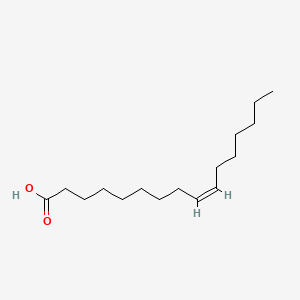Possible associated with:
| Structure | name | description | Reference count |
|---|---|---|---|

|
cis-9-palmitoleic acid | Cis-9-palmitoleic acid is a lipid of Fatty Acyls (FA) class. | 694 |

|
7-octadecynoic acid | 7-octadecynoic acid is a lipid of Fatty Acyls (FA) class. | 8379 |

|
11beta-PGF2 | 11beta-pgf2 is a lipid of Fatty Acyls (FA) class. | 15009 |

|
1-Oleoyl Lysophosphatidic Acid | 1-Oleoyl Lysophosphatidic Acid is a lipid of Glycerophospholipids (GP) class. 1-oleoyl lysophosphatidic acid is associated with abnormalities such as Myocardial Infarction, early pregnancy, Scleroderma, Blind Vision and Hyperlipidemia. The involved functions are known as Agent, Blood coagulation, Selection, Genetic, Analyte and Biological Processes. 1-oleoyl lysophosphatidic acid often locates in Tissue specimen, Body tissue, Blood, Membrane and Skin. The associated genes with 1-Oleoyl Lysophosphatidic Acid are Mucin-16, Peptides, SMAD4 gene, RND1 gene and Polypeptides. The related lipids are lysophosphatidic acid, A(2)C, Lysophospholipids, Fatty Acids and sphingosine 1-phosphate. The related experimental models are Mouse Model, Knock-out, Cancer Model, Xenograft Model and Arthritis, Adjuvant-Induced. | 3463 |

|
trichostatin A | Trichostatin is a lipid of Polyketides (PK) class. Trichostatin is associated with abnormalities such as Dentatorubral-Pallidoluysian Atrophy, PARAGANGLIOMAS 3, abnormal fragmented structure, Disintegration (morphologic abnormality) and Hyperostosis, Diffuse Idiopathic Skeletal. The involved functions are known as Acetylation, Cell Differentiation process, histone modification, Gene Silencing and Transcriptional Activation. Trichostatin often locates in CD41a, Hematopoietic System, Chromatin Structure, Blood and Endothelium. The associated genes with Trichostatin are SPI1 gene, CELL Gene, Chromatin, CXCR4 gene and DNMT1 gene. The related lipids are Butyrates, Promega, butyrate, Lipopolysaccharides and Steroids. The related experimental models are Knock-out, Mouse Model, Xenograft Model and Cancer Model. | 5401 |

|
quercetin | quercetin is a lipid of Polyketides (PK) class. Quercetin is associated with abnormalities such as Coronary heart disease, Myocardial Infarction, Cirrhosis, Coronary Arteriosclerosis and Vascular ring. The involved functions are known as Vasodilation, physiological aspects, Fermentation, Process and Ingredient. Quercetin often locates in Arterial system, Endothelium, Skin, Endothelium, Vascular and Tissue specimen. The associated genes with quercetin are P4HTM gene, SULT gene, UGT1A1 gene, ARHGAP26 gene and PLXNB1 gene. The related lipids are blood lipid, Promega, Steroids, Phosphatidylserines and Fatty Acids. The related experimental models are Knock-out, Mouse Model, Xenograft Model, Tissue Model and Cancer Model. | 5377 |
Total
6